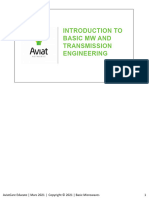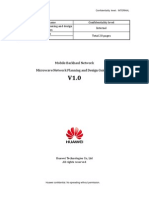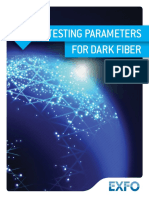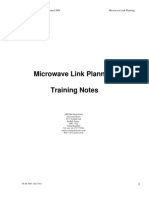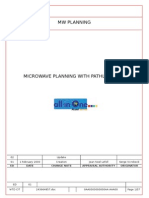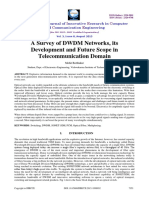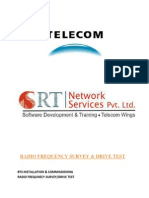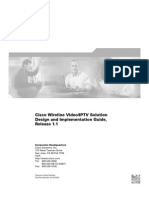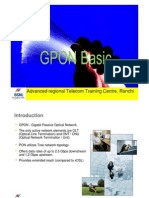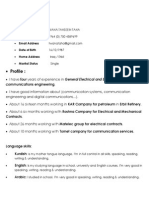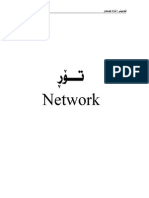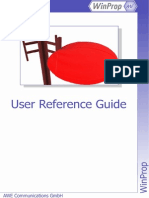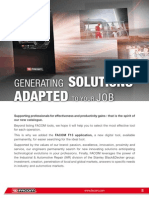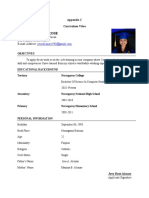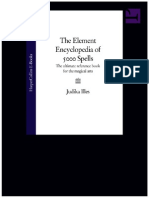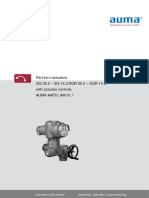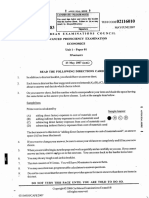MW Transmission Network Planning
MW Transmission Network Planning
Uploaded by
Hogr RgohCopyright:
Available Formats
MW Transmission Network Planning
MW Transmission Network Planning
Uploaded by
Hogr RgohOriginal Description:
Copyright
Available Formats
Share this document
Did you find this document useful?
Is this content inappropriate?
Copyright:
Available Formats
MW Transmission Network Planning
MW Transmission Network Planning
Uploaded by
Hogr RgohCopyright:
Available Formats
MICROWAVE TRANSMISSION NETWORK PLANNING
Technical Support Departement
2/28/2008
Huawei Technology Co.Ltd
MICROWAVE TRANSMISSION NETWORK PLANNING
Transmission Network Design Activities
Nominal Network Planning
Preliminary Equipment Specification
Final Capacity Planning
Network routing
Final Network Lay out
Equipment Specification
Map Studies, Actual LOS survey, Site Survey
Network Design
Site candidates priority from transmission point of view
Line of Sight Survey
Preliminary equipment dimensioning & design
Site Selection
Topology Selection
Transmission Media Selection
Preliminary capacity planning
Nominal network layout
Final equipment specification (Microwave BoQ)
Microwave Path & Frequency Planning
Link Budget Calculation
Prediction of Performance & Availability Calculation
Frequency Planning
2/28/2008
Huawei Technology Co.Ltd
MICROWAVE TRANSMISSION NETWORK PLANNING
Nominal Network Planning
Topology Planning
There are several basic Network / Topology Planning,
each has its own advantages and disadvantages
Chain Configuration
Star Configuration
Ring Configuration
Tree Configuration
Cluster Configuration
2/28/2008
Huawei Technology Co.Ltd
MICROWAVE TRANSMISSION NETWORK PLANNING
Topology Planning
Chain Configuration
This configuration is suitable
when providing radio coverage
along road
+
Low concentration of equipment at nodal
points
Cascading / multi drop possibility
High Capacities at end nodal point
Reliability issues since unavailability
targets are cumulative
2/28/2008
Huawei Technology Co.Ltd
MICROWAVE TRANSMISSION NETWORK PLANNING
Topology Planning
Star Configuration
This configuration is suitable in
small network
+
Each path is independent of the rest of
traffic
Effect of link failure is limited
High concentration of equipments at
nodal point
Requires a lot of frequency channel
2/28/2008
Huawei Technology Co.Ltd
MICROWAVE TRANSMISSION NETWORK PLANNING
Topology Planning
Ring Configuration
This configuration is suitable
when high availability is required
+
+
Link Availability
Theres always an alternate path in case
of link failure
BTS traffic must be connected with two
other sites
Equipment cost
All link must be able to handle the full
capacity
2/28/2008
Huawei Technology Co.Ltd
MICROWAVE TRANSMISSION NETWORK PLANNING
Topology Planning
Tree Configuration
This configuration is suitable in
small to medium network
+
Ease of frequency utilization
Link Availability
Link Failure may affect some sites
2/28/2008
Huawei Technology Co.Ltd
MICROWAVE TRANSMISSION NETWORK PLANNING
Topology Planning
Cluster Configuration
This configuration is suitable for
larger network. They are divided
into sub-networks or cluster and
connected to a common nodal
point
+
+
+
Availability
Shorter path from all sites to nodal point
Distributed transmission capacity
2/28/2008
Huawei Technology Co.Ltd
MICROWAVE TRANSMISSION NETWORK PLANNING
Preliminary Capacity Planning
With overall picture
in mind about
topology selection,
we can now plan the
initial E1 capacities
taking into
consideration BTS
configuration
2/28/2008
Huawei Technology Co.Ltd
MICROWAVE TRANSMISSION NETWORK PLANNING
Nominal Network Layout & Preliminary Equipment Specification
Refer to topology
planning and preliminary
capacity planning, we
can define the nominal
network layout &
preliminary equipment
specification
Link distance can be
measured nominally with
planning tools (map info,
digital map) refer to
Max Path Length
Calculation
2/28/2008
Huawei Technology Co.Ltd
MICROWAVE TRANSMISSION NETWORK PLANNING
Site Selection (Pre-Survey Procedure)
Transmission planning team has played a major role in
deciding which site candidates are feasible or not
Need nominal coordinate of all candidates from RF team
Transmission planning team should scan the surrounding
topographical condition of each candidates and study the
possibility to all alternate far end
Mark down any possible obstruction
Site candidate priority list, from transmission point of
view should base on :
LOS possibility to far end
Surrounding topographical condition
Maximum tower height will be built (refer to land space)
Availability of leased line connection in case microwave implementation
is not possible
2/28/2008
Huawei Technology Co.Ltd
MICROWAVE TRANSMISSION NETWORK PLANNING
Line of Sight (LOS) Survey
To verify that the proposed network design is feasible
considering line-of-sight constrain. LOS survey is
performed in parallel with network design
Basically, LOS survey is consist three main activities as
follows :
Map Studies
Actual Line-of-Site Survey
Site Investigation
Further details of LOS survey procedure already discuss
in the previous session
2/28/2008
Huawei Technology Co.Ltd
MICROWAVE TRANSMISSION NETWORK PLANNING
Site Survey
Even when we have a clear Line of Sight of a proposed
link, we cannot declare a link is LOS before the following
requirement are met :
Tower space for the proposed antenna
Space in the vertical & horizontal tray for feeder or coaxial cable
Availability of penetration hole to the shelter
Indoor equipment space (IDU space at 19 rack)
Those above requirement can be check on site survey
Further details of Site Survey procedure already discuss
in the previous session
2/28/2008
Huawei Technology Co.Ltd
MICROWAVE TRANSMISSION NETWORK PLANNING
Final Network Design & Final Equipment Specification
Refer to the result of LOS survey and Site Survey,
Transmission planner can finalized the network design
and deliver the final microwave BoQ
Microwave BoQ will cover :
Microwave Radio Frequency
Equipment configuration and capacity
Feeder / Coaxial cable length
Antenna mounting type
Requirement of 19 rack
2/28/2008
Huawei Technology Co.Ltd
MICROWAVE TRANSMISSION NETWORK PLANNING
Microwave Path & Frequency Planning
At this stage, transmission planner will calculate the
performance prediction and Frequency interference
planning
Performance prediction provides information on the
expected performance of each microwave link. This is
where fading and other sort of distortion is anticipated
satisfying the intended link budget
Frequency planning provides information on the uninterfered channel on particular transmission link. This is
where exact frequencies are assigned including
recommended Tx power, calculated Rx level, antenna
size and polarization.
Both performance prediction & frequency planning can
be done with microwave planning tools e.g. Pathloss 4.0
2/28/2008
Huawei Technology Co.Ltd
MICROWAVE TRANSMISSION NETWORK PLANNING
Calculating the Link Budget
POWER
Antenna
gain
Free space loss + gas
absorption + obstacle loss
Output
power
Wave Propagation
Loss
Feeder loss
Feeder loss
Received Power
Antenna
gain
Fade Margin
Receiver
Threshold Value
2/28/2008
Huawei Technology Co.Ltd
Fade Margin should be
large enough to guarantee
that quality and availability
objectives are met during
fading condition
MICROWAVE TRANSMISSION NETWORK PLANNING
Performance Prediction : Fading
DIFFRACTION
REFFRACTION
2/28/2008
REFFLECTION
Huawei Technology Co.Ltd
MICROWAVE TRANSMISSION NETWORK PLANNING
Performance Prediction : KPI
Unavailable Time (UAT) = A period when the BER in each second of the 10
consecutive second is worse than 10-3
Error Seconds (ES) = Seconds during which BER is worse than 10-6
Severely Error Seconds (SES) = Error seconds with a BER worse than 10-3
Degraded Minute (DM) = The percentage of the total AT during a measured
period for which the BER is worse than 10-6 but better than 10-3
UAT
DM
ES
SES
2/28/2008
: Rain Fading + Hardware Unavailability
: Rain Fading + Multipath Fading
: Rain Fading + Multipath Fading
: Multipath Fading
Huawei Technology Co.Ltd
MICROWAVE TRANSMISSION NETWORK PLANNING
Performance Prediction : KPI
2/28/2008
Huawei Technology Co.Ltd
MICROWAVE TRANSMISSION NETWORK PLANNING
Performance Prediction : Transmission Planning Objectives
System Flat Fade Margin > 35 dB (depend on
frequency), but recommended <50 db to avoid over
spec and interference
SESR for worst month cannot exceed 0.002% of total
available time (99.998% performance, ITU-R 1491
recommendation for PDH), which is maximum
31.2 second/month
Annual availability cannot exceed 0.005% of total time
(99.995% availability, ITU-R F.557 and F.695), which is
maximum 30 minutes/year
2/28/2008
Huawei Technology Co.Ltd
MICROWAVE TRANSMISSION NETWORK PLANNING
Performance Prediction : Pathloss 4.0
2/28/2008
Huawei Technology Co.Ltd
MICROWAVE TRANSMISSION NETWORK PLANNING
Performance Prediction : Microwave Equipment Dimensioning
To Improve the Fade Margin value :
To Improve the SESR value :
Increase the antenna gain (by using antenna with larger diameter)
Use high power radios (with greater transmit power)
Using space diversity antenna to overcome the multipath fading
Change the antenna position at NE and FE to get more path inclination
value. Larger path inclination value will decrease the multipath fading
To Improve the unavailability value :
Change the radio equipment to lower frequency, since Rain Fading is
the main aspect of UAT value. Rain Fading will have more impact on
high frequency system (15-38 GHz). On the frequency 7GHz or below
Rain Fading factor is not dominant.
2/28/2008
Huawei Technology Co.Ltd
MICROWAVE TRANSMISSION NETWORK PLANNING
THANK YOU
2/28/2008
Huawei Technology Co.Ltd
You might also like
- Basic Microwave PPT - V2.2Document147 pagesBasic Microwave PPT - V2.2mohamudNo ratings yet
- Blair ICBM Code ResponseDocument2 pagesBlair ICBM Code ResponseDan LamotheNo ratings yet
- TETRA GSM PlanningDocument35 pagesTETRA GSM Planningnm7713No ratings yet
- Microwave Network Planning and Design Guidelines V1.0Document20 pagesMicrowave Network Planning and Design Guidelines V1.0Sidy Elbechir Drame100% (2)
- ECM1500 Series 2Document2 pagesECM1500 Series 2Hogr RgohNo ratings yet
- Dukan Diet SummaryDocument6 pagesDukan Diet SummaryLavinia DumitruNo ratings yet
- Radio Network Planning and Optimisation for UMTSFrom EverandRadio Network Planning and Optimisation for UMTSJaana LaihoRating: 4.5 out of 5 stars4.5/5 (2)
- Backhauling / Fronthauling for Future Wireless SystemsFrom EverandBackhauling / Fronthauling for Future Wireless SystemsKazi Mohammed Saidul HuqNo ratings yet
- Radio Spectrum Management: Policies, Regulations and TechniquesFrom EverandRadio Spectrum Management: Policies, Regulations and TechniquesNo ratings yet
- Pathloss Training NECDocument77 pagesPathloss Training NECBabar Nawaz Khan100% (4)
- Unit 1: Telecommunications Concepts or "Here Is A Flyover From 50,000 Feet." Dr. Antone KusmanofDocument38 pagesUnit 1: Telecommunications Concepts or "Here Is A Flyover From 50,000 Feet." Dr. Antone Kusmanofssulank100% (1)
- Telecommunication Network Design - Microwave Link DesignDocument86 pagesTelecommunication Network Design - Microwave Link DesignJorma Kekalainen100% (1)
- RTN 910/950 Dimmensioning: IntroducingDocument94 pagesRTN 910/950 Dimmensioning: IntroducingGaddy GumbaoNo ratings yet
- Point To Point MicrowaveDocument81 pagesPoint To Point MicrowaveRicha BudhirajaNo ratings yet
- Atoll Microwave 3 2 0 Detailed Overview May 2013 enDocument46 pagesAtoll Microwave 3 2 0 Detailed Overview May 2013 enprabhat_praveenNo ratings yet
- 5G-EnSURE D2.7 SecurityArchitectureFinalDocument81 pages5G-EnSURE D2.7 SecurityArchitectureFinalAnusandhanManchheNo ratings yet
- G-LII 202 Planning For Radio Coverage Capacity-20080312-A-2.1Document26 pagesG-LII 202 Planning For Radio Coverage Capacity-20080312-A-2.1naveedalishaNo ratings yet
- FTTX NetworksDocument194 pagesFTTX NetworksNtsane MoleNo ratings yet
- Atoll 3.2.0 User Manual MWDocument304 pagesAtoll 3.2.0 User Manual MWbadr talamineNo ratings yet
- Spectrum Management Training Course PDFDocument3 pagesSpectrum Management Training Course PDFSACIIDNo ratings yet
- Gigabit Passive Optical NetworksDocument37 pagesGigabit Passive Optical NetworksMuhamad Hasan McKaganNo ratings yet
- 5G ArchitectureDocument8 pages5G ArchitectureperltechieNo ratings yet
- Flexi Network Server - Rel 15 - Operating PDFDocument1 pageFlexi Network Server - Rel 15 - Operating PDFOmar Clavijo0% (1)
- Design Enterprise Wireless Local Area Network - Enterprise Wireless LANDocument15 pagesDesign Enterprise Wireless Local Area Network - Enterprise Wireless LANArkabho Biswas100% (1)
- Ericsson Microwave Certification Exam TopicsDocument1 pageEricsson Microwave Certification Exam TopicsAnwar SniedNo ratings yet
- IBS Presentation Sharing Session-TBG PDFDocument39 pagesIBS Presentation Sharing Session-TBG PDFagungcomlNo ratings yet
- RTN950ADocument2 pagesRTN950AClaire100% (1)
- Telecomunications Cabling Specification v5Document77 pagesTelecomunications Cabling Specification v5Tamer Elmaghraby100% (1)
- Telecommunications LawDocument4 pagesTelecommunications LawSWATINo ratings yet
- Exfo Guide Key Testing Parameter For Dark Fiber enDocument20 pagesExfo Guide Key Testing Parameter For Dark Fiber enJose SanchezNo ratings yet
- Design Planning and Installation Ed 3x4Document182 pagesDesign Planning and Installation Ed 3x4juliosieteNo ratings yet
- 3g To 4g Migration - ArticleDocument3 pages3g To 4g Migration - ArticleRajesh PorwalNo ratings yet
- Microwave Link DesignDocument68 pagesMicrowave Link DesignMatthew CarterNo ratings yet
- Issi-Cssi Primer Final 508cDocument15 pagesIssi-Cssi Primer Final 508cAndrea Fox100% (1)
- Training On Microwave Communcation: by Nilesh PatelDocument39 pagesTraining On Microwave Communcation: by Nilesh PatelKo AungNo ratings yet
- Aircom Microwave Link PlanningDocument192 pagesAircom Microwave Link PlanningEmerson ValadãoNo ratings yet
- Link Budget Calculation - Tranzeo Link Budget WhitepaperDocument4 pagesLink Budget Calculation - Tranzeo Link Budget Whitepapernassr_ismail100% (1)
- MW Planning With Path Loss 4Document57 pagesMW Planning With Path Loss 4kamkamtoy100% (1)
- Image Encryption Using 2D Chaotic Ma Presented by Nazish KhalidDocument39 pagesImage Encryption Using 2D Chaotic Ma Presented by Nazish KhalidNazish KhalidNo ratings yet
- ODD010010 IP Backbone Network Planning ISSUE 1 - 2Document68 pagesODD010010 IP Backbone Network Planning ISSUE 1 - 2Randy DookheranNo ratings yet
- EXFO Technical Note 38Document8 pagesEXFO Technical Note 38accumulatorNo ratings yet
- A Survey of DWDM Network1sDocument6 pagesA Survey of DWDM Network1sKarthic ShunmugarajNo ratings yet
- Bts Installation & Commissioning Radio Frequnecy Survey/Drive TestDocument7 pagesBts Installation & Commissioning Radio Frequnecy Survey/Drive TestAshok KumarNo ratings yet
- Nokia Optical Anyhaul White Paper enDocument16 pagesNokia Optical Anyhaul White Paper enheom123100% (1)
- IBS For EngineerDocument185 pagesIBS For EngineerQuyết Lê ĐứcNo ratings yet
- MTN Ghana Case Study - Aviat Networks Services and ProVisionDocument3 pagesMTN Ghana Case Study - Aviat Networks Services and ProVisionSCgmailNo ratings yet
- ResumeDocument7 pagesResumedpprasad2No ratings yet
- 3) Link Budget DesigningDocument142 pages3) Link Budget Designinggargee502No ratings yet
- Cisco Wireline Video IPTV Solution Design and Implementation Guide, Release 1.1Document376 pagesCisco Wireline Video IPTV Solution Design and Implementation Guide, Release 1.1Mai TrungNo ratings yet
- Optical Communication NetworksDocument4 pagesOptical Communication Networksarivurp100% (1)
- Gpon Basics - BSNLDocument26 pagesGpon Basics - BSNLBob CoxNo ratings yet
- Microwave Transmission Networks Planning, Design, and Deployment, Second Edition - Harvey LehpamerDocument3 pagesMicrowave Transmission Networks Planning, Design, and Deployment, Second Edition - Harvey LehpamerjankpesNo ratings yet
- Juniper Networks mx480 PDFDocument366 pagesJuniper Networks mx480 PDFoun2006100% (1)
- Microwave Transmission NetworkDocument3 pagesMicrowave Transmission NetworkUjlfoDibnvbiNo ratings yet
- LTE RAN Planning CourseDocument2 pagesLTE RAN Planning CoursetetraprimigNo ratings yet
- The Power of TETRA-Direct Mode Operation-Selex Communications Francesco PasqualiDocument29 pagesThe Power of TETRA-Direct Mode Operation-Selex Communications Francesco PasqualiGuGazNo ratings yet
- LTE Self-Organising Networks (SON): Network Management Automation for Operational EfficiencyFrom EverandLTE Self-Organising Networks (SON): Network Management Automation for Operational EfficiencySeppo HämäläinenNo ratings yet
- Understanding UMTS Radio Network Modelling, Planning and Automated Optimisation: Theory and PracticeFrom EverandUnderstanding UMTS Radio Network Modelling, Planning and Automated Optimisation: Theory and PracticeMaciej NawrockiNo ratings yet
- RTN 980 V100R009C10 Maintenance Guide 02 PDFDocument1,400 pagesRTN 980 V100R009C10 Maintenance Guide 02 PDFHogr RgohNo ratings yet
- MW Transmission Network PlanningDocument23 pagesMW Transmission Network PlanningHogr RgohNo ratings yet
- Chapter One Introduction To Fiber OpticDocument28 pagesChapter One Introduction To Fiber OpticHogr RgohNo ratings yet
- VR New FucntionsDocument35 pagesVR New FucntionsHogr Rgoh100% (2)
- Introduction 1Document5 pagesIntroduction 1Hogr RgohNo ratings yet
- Engineer: Your Name Telecommunication EngineerDocument3 pagesEngineer: Your Name Telecommunication EngineerHogr RgohNo ratings yet
- Al Sard Group Company HR DepartmentDocument3 pagesAl Sard Group Company HR DepartmentHogr RgohNo ratings yet
- Twana Tahseen Taha CVDocument2 pagesTwana Tahseen Taha CVHogr RgohNo ratings yet
- Mentum Planet LTE Plan For RFDocument12 pagesMentum Planet LTE Plan For RFHogr RgohNo ratings yet
- HogrF. OmerDocument5 pagesHogrF. OmerHogr RgohNo ratings yet
- Cv32223683 Hogr Fatih Telecommunication EngineerDocument3 pagesCv32223683 Hogr Fatih Telecommunication EngineerHogr RgohNo ratings yet
- Ccna Commands in ArabicDocument66 pagesCcna Commands in ArabicHogr RgohNo ratings yet
- WiMAX OverviewDocument6 pagesWiMAX Overviewrebin1988No ratings yet
- Network KurdishhhhDocument49 pagesNetwork KurdishhhhHogr Rgoh100% (1)
- A Man ManualDocument119 pagesA Man ManualHogr RgohNo ratings yet
- Generating SolutionDocument1 pageGenerating SolutionHogr RgohNo ratings yet
- 14 Bernardo Soustruhy deDocument40 pages14 Bernardo Soustruhy deTanase Constantin0% (1)
- Rolling Technology Training Programme - AnnealingDocument52 pagesRolling Technology Training Programme - Annealingrabikm100% (1)
- Alcazar, Juvy Rose: 423 Partida Norzagaray Bulacan Cell Number:09065936659 E-Mail AddressDocument15 pagesAlcazar, Juvy Rose: 423 Partida Norzagaray Bulacan Cell Number:09065936659 E-Mail AddressT VinassaurNo ratings yet
- SAPS - Auxin Investigations - Effects of IAA On Root Growth - Students GuideDocument7 pagesSAPS - Auxin Investigations - Effects of IAA On Root Growth - Students GuidesabaNo ratings yet
- Chapter 8Document6 pagesChapter 8Jenny LagundayNo ratings yet
- Civilisation, in The Real Sense of The Term, Consists Not in The Multiplication, But in The Deliberate and Voluntary Reduction of Wants."Document4 pagesCivilisation, in The Real Sense of The Term, Consists Not in The Multiplication, But in The Deliberate and Voluntary Reduction of Wants."Stephanie White Tulip PopescuNo ratings yet
- GCC Core Log 2023-08-28Document5 pagesGCC Core Log 2023-08-28Zaki MarufanNo ratings yet
- AlohaDocument2 pagesAlohaTung NguyenNo ratings yet
- 14 Plastic ProcessingDocument20 pages14 Plastic Processingrkd2743No ratings yet
- 04-A202-Plant Development - Coursework AssignmentDocument10 pages04-A202-Plant Development - Coursework AssignmentFakrurazi NajmiNo ratings yet
- ASTM - STP 234 - Symposium On Particle Size MeasurementDocument314 pagesASTM - STP 234 - Symposium On Particle Size MeasurementeduardoNo ratings yet
- 2018 NBPC Blueprint Written Business Plan PDFDocument28 pages2018 NBPC Blueprint Written Business Plan PDFDesainCADNo ratings yet
- 1377911235686Document901 pages13779112356862014592% (12)
- Grade 4 DLL Quarter 2 Week 3-ArmanDocument44 pagesGrade 4 DLL Quarter 2 Week 3-ArmanMorente Villarin ALNo ratings yet
- DWDMDocument33 pagesDWDMMahesh Kamath NNo ratings yet
- Drawings: EJX310B Absolure Pressure TransmitterDocument1 pageDrawings: EJX310B Absolure Pressure TransmitterLaurence MalanumNo ratings yet
- Business Continuity ManagementDocument3 pagesBusiness Continuity ManagementmusshahrazatNo ratings yet
- Oracle Code For Decomissioned EquipmentDocument128 pagesOracle Code For Decomissioned Equipmentnagulapallisagar100% (1)
- Role Conductor Schuller PDFDocument5 pagesRole Conductor Schuller PDFSaxoFloxNo ratings yet
- Dosage Calculations.30180642Document18 pagesDosage Calculations.30180642Abdul MajidNo ratings yet
- Iso 10855 1 2018 en PDFDocument11 pagesIso 10855 1 2018 en PDFBernardoGonzalezNo ratings yet
- 6822 - Pimpri Chinchwad Education Trust's Pimpri Chinchwad College of Engineering and Research, RavetDocument5 pages6822 - Pimpri Chinchwad Education Trust's Pimpri Chinchwad College of Engineering and Research, RavetMayur BahiratNo ratings yet
- Part-Turn Actuators SQ With Actuator Control AM01 1Document72 pagesPart-Turn Actuators SQ With Actuator Control AM01 1popyNo ratings yet
- Pumps and Pumping StationsDocument10 pagesPumps and Pumping Stationskpostulart100% (2)
- Rakshitha CVDocument4 pagesRakshitha CVMydri GopinathNo ratings yet
- Joerez Chavez ResumeDocument18 pagesJoerez Chavez ResumeJulie Ann ChavezNo ratings yet
- ™ Alt+0153 ← © ↔ ® £ ‰ Alt+0137 Per mille (per thousand) € ± $ ¼ ¢ ½ ¥ ¾ ƒ ≡ ₧ ≈ α ≥ ß ≤ δ √ Ω ⁿ ► ¹ ◄ ² ■ ³ ▲ π ▼ ° § ∞ ¶ µ " Σ " ☺ « ☻ » - ♥ ○ º ♂ œ ♀ - ↨ ↻ ↑ ↺ ↓ Ø → ÑDocument2 pages™ Alt+0153 ← © ↔ ® £ ‰ Alt+0137 Per mille (per thousand) € ± $ ¼ ¢ ½ ¥ ¾ ƒ ≡ ₧ ≈ α ≥ ß ≤ δ √ Ω ⁿ ► ¹ ◄ ² ■ ³ ▲ π ▼ ° § ∞ ¶ µ " Σ " ☺ « ☻ » - ♥ ○ º ♂ œ ♀ - ↨ ↻ ↑ ↺ ↓ Ø → ÑMonik kotadiaNo ratings yet
- CAPE Economics 2007 U1 P1Document10 pagesCAPE Economics 2007 U1 P1aliciaNo ratings yet
